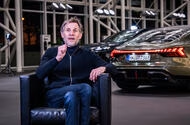What Does Vorsprung durch Technik Really Mean to Audi Designers?
Ask anyone in the automotive world about Audi’s identity, and you’ll likely hear those three iconic German words: Vorsprung durch Technik. It translates to progress through technology, but for the people shaping Audi’s future, it’s much more than a slogan. Frank Lamberty, the creative force behind the legendary R8 and the all-electric e-tron GT, sees it as a mindset—a relentless drive to innovate, adapt, and push boundaries.
How Did Audi’s Philosophy Shape Its History?
Audi’s journey hasn’t always been smooth. Back in the 1960s, the company was just a cog in the larger Auto Union machine, owned by Mercedes-Benz and later Volkswagen. The turning point? A handful of determined engineers secretly designed the Audi 100, a car so forward-thinking it convinced the board to give Audi a new lease on life. That spirit—spotting what’s not working and daring to do better—became the heart of Vorsprung durch Technik. It’s not just about technology for technology’s sake; it’s about knowing when to break the mold and find a smarter way forward.
Where Do Audi Designers Find Their Inspiration?
For Lamberty and his team, inspiration is everywhere, but especially in the natural world. He describes walking through life with his eyes wide open, always searching for shapes, forms, and even animal characteristics that can translate into car design. It’s not just about copying what you see—it’s about understanding why something works, and then reimagining it in a new context. That’s how you end up with cars that feel alive, not just assembled.
What Defines Audi’s Design Language in the Electric Age?
Audi’s design ethos has always been about reduction—stripping away the unnecessary to let the essential shine. Think of the first-generation Audi TT: its purity and clean lines meant that even the tiniest misstep in proportion would stand out. Lamberty calls this the logic of the lines. Every crease, every volume, every shut line has a reason for being there. The e-tron GT’s muscular haunches, for example, aren’t just for show—they hint at the power beneath the surface.
But Audi design isn’t just about logic; it’s about emotion. A car should move you, not just physically but emotionally. The best designs, like the e-tron family, blend form and function so seamlessly that you feel something just looking at them.
Which Audi Models Stand Out as Design Milestones?
Ask Lamberty about his favorites, and the original TT comes up immediately. Its Bauhaus-inspired simplicity blurred the line between car and product design, making it a true icon. But there are other standouts: the clever, lightweight Audi A2, which maximized interior space and aerodynamics long before efficiency became a buzzword; and the A6 Allroad, which responded to the SUV craze by blending versatility with unmistakable Audi style.
Each of these cars embodies Vorsprung durch Technik—not just in their engineering, but in their willingness to rethink what a car can be.
How Has Electric Mobility Changed Car Design at Audi?
Electric vehicles have rewritten the rules of car design. At first, designers rejoiced at the absence of bulky engines, imagining endless freedom. The reality? New challenges, especially when it comes to battery placement. Batteries in the floor raise the car’s height, which can be tricky for sports cars like the e-tron GT. Audi’s solution: a modular battery system that keeps the floor low and the silhouette sleek.
There are upsides, too. Electric cars need big wheels to handle the weight, and designers love big wheels. With batteries centralized, wheels can be pushed out to the corners, creating dynamic proportions and shorter overhangs. Aerodynamics have also become paramount, with every e-tron model shaped to slice through the air for maximum efficiency.
What Makes Each e-tron Model Unique in Design?
Lamberty lights up talking about the e-tron GT. Its long wheelbase, floating roof arc, and muscular wheel arches make it feel like a sculpture in motion. The Q6 e-tron, its SUV sibling, carries similar DNA—strong front end, wide stance, and those signature haunches. Then there’s the A6 e-tron Avant, Audi’s first electric wagon. With a smooth, elongated body and a single, uninterrupted crease, it’s designed to visually express airflow, combining practicality with elegance.
How Will Vorsprung durch Technik Shape Audi’s Future?
Audi stands at a crossroads, with the automotive landscape shifting rapidly. But if history is any guide, that’s when Vorsprung durch Technik shines brightest. Lamberty believes the brand’s future will be defined by its willingness to experiment, improve, and never settle for the status quo. Whether it’s rethinking battery layouts or inventing new forms, the core philosophy remains: progress isn’t just about new tech—it’s about bold ideas and the courage to act on them.
The big takeaway? Progress through technology isn’t about perfection—it’s about smarter adjustments. Start with one change this week, and you’ll likely spot the difference by month’s end.

